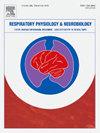用“理想”肺泡气体的概念和在通气动物中用可能的方法测定PAO2
IF 1.6
4区 医学
Q3 PHYSIOLOGY
引用次数: 0
摘要
理想肺泡气体概念在肺泡气体方程中使用动脉(PaCO2)而不是肺泡(PaCO2)二氧化碳分压来计算肺泡氧分压(PAO2)。我们比较了分流对“理想”气体概念计算的PAO2的影响,以及使用多重惰性气体消除技术(MIGET)计算的PAO2。我们检验了分流影响PACO2的假设,并在两种实验猪模型中引入了PAO2估计的显著误差。首先,在肺灌洗模型(n = 10)中,施加不同水平的呼气末正压诱导分流改变。PaCO2中位值71 mmHg, (IQR 21 mmHg)高于MIGET PaCO2 52(20) mmHg (p <; 0.001)。理想PAO2 654(33) mmHg低于MIGET PAO2 670(19) mmHg (p <; 0.001)。PAO2的偏倚为- 23 mmHg,一致限度在19至- 65 mmHg之间。其次,在单肺通气模型(n = 10)中,通过下腔静脉球囊充气(OLVCB)降低心输出量,硝普酸(OLVNPS)抑制缺氧肺收缩,多巴酚丁胺(OLVDBT)增加心输出量。基线PaCO2为55(10)mmHg,分流率为9(19)%。心输出量减少不影响PaCO2 57(9) mmHg (p = 0.19)或分流9(15)% (p = 0.570)。抑制缺氧肺血管收缩增加PaCO2 [62(13) mmHg;P = 0.083]和分流[26(20)%;p = 0.020]。心输出量增加导致PaCO2升高[67(11)mmHg;P = 0.004]和分流[30(29)%;p = 0.012]。理想气体概念中PaCO2不受分流影响的假设是不正确的,在肺泡气体方程中引入了显著的估计误差。本文章由计算机程序翻译,如有差异,请以英文原文为准。
Determination of PAO2 by the “ideal” alveolar gas concept and by miget in ventilated animals
The Ideal Alveolar Gas Concept calculates the alveolar partial pressure of oxygen (PAO2) using arterial (PaCO2) instead of alveolar (PACO2) partial pressures of carbon dioxide in the alveolar gas equation. We compared the effects of shunt on PAO2 calculated by the “ideal” gas concept with a calculation using the multiple inert gas elimination technique (MIGET). We tested the hypothesis that shunt affects PACO2 and introduces significant errors in the estimation of PAO2 in two experimental porcine models. First, in a lung-lavage model (n = 10), shunt changes were induced by applying different levels of positive end-expiratory pressure. PaCO2 median 71 mmHg, (IQR 21 mmHg) was higher than MIGET PACO2 52(20) mmHg (p < 0.001). Ideal PAO2 654(33) mmHg was lower than MIGET PAO2 670(19) mmHg (p < 0.001). Bias in PAO2 was −23 mmHg with limits of agreement between 19 to −65 mmHg. Second, in a one-lung ventilation model (n = 10), changes in shunt were performed decreasing cardiac output by inferior vena cava balloon inflations (OLVCB), inhibiting hypoxic pulmonary constriction with nitroprusiate (OLVNPS) and increasing cardiac output with dobutamine (OLVDBT). Baseline PaCO2 was 55(10) mmHg and shunt 9(19)%. Cardiac output reduction did not affect PaCO2 57(9) mmHg (p = 0.19) or shunt 9(15)% (p = 0.570). Inhibiting hypoxic pulmonary vasoconstriction increased PaCO2 [62(13) mmHg; p = 0.083] and shunt [26(20)%; p = 0.020]. Cardiac output increase resulted in higher PaCO2 [67(11) mmHg; p = 0.004] and shunt [30(29)%; p = 0.012]. The assumption of the ideal gas concept that PaCO2 is not affected by shunt is incorrect introducing significant estimation errors in the alveolar gas equation.
求助全文
通过发布文献求助,成功后即可免费获取论文全文。
去求助
来源期刊
CiteScore
4.80
自引率
8.70%
发文量
104
审稿时长
54 days
期刊介绍:
Respiratory Physiology & Neurobiology (RESPNB) publishes original articles and invited reviews concerning physiology and pathophysiology of respiration in its broadest sense.
Although a special focus is on topics in neurobiology, high quality papers in respiratory molecular and cellular biology are also welcome, as are high-quality papers in traditional areas, such as:
-Mechanics of breathing-
Gas exchange and acid-base balance-
Respiration at rest and exercise-
Respiration in unusual conditions, like high or low pressure or changes of temperature, low ambient oxygen-
Embryonic and adult respiration-
Comparative respiratory physiology.
Papers on clinical aspects, original methods, as well as theoretical papers are also considered as long as they foster the understanding of respiratory physiology and pathophysiology.

 求助内容:
求助内容: 应助结果提醒方式:
应助结果提醒方式:


